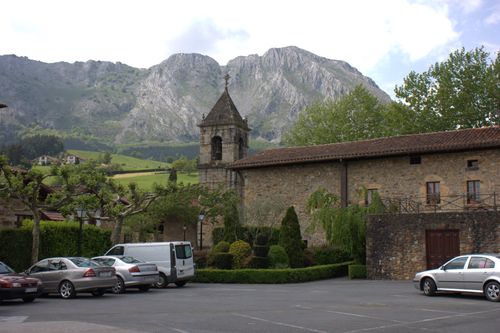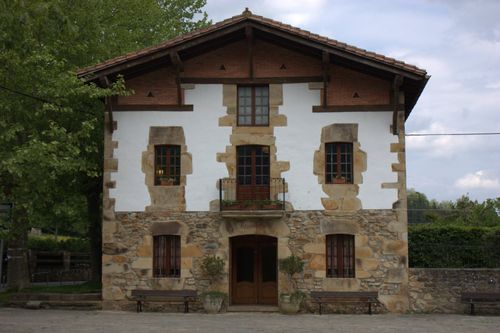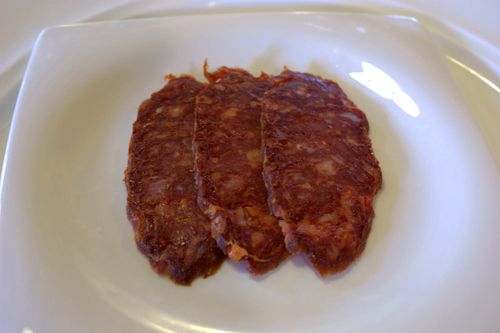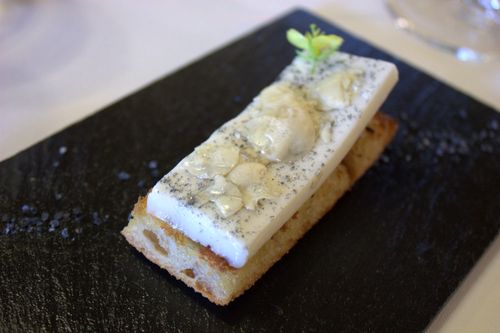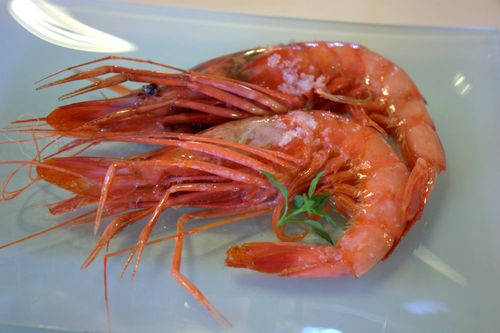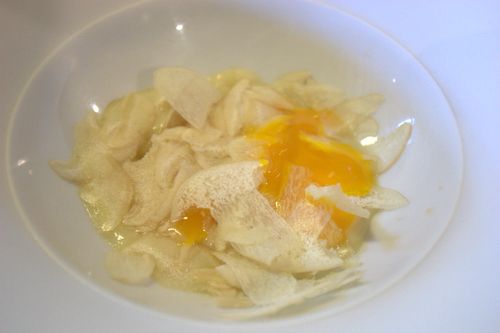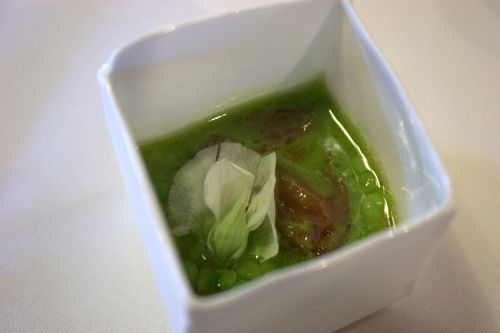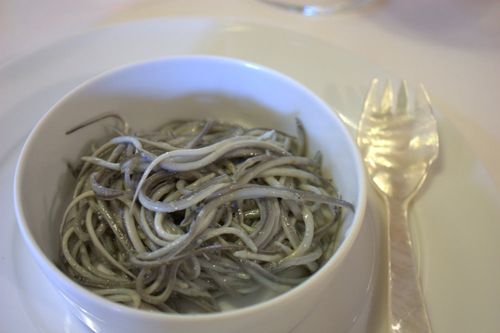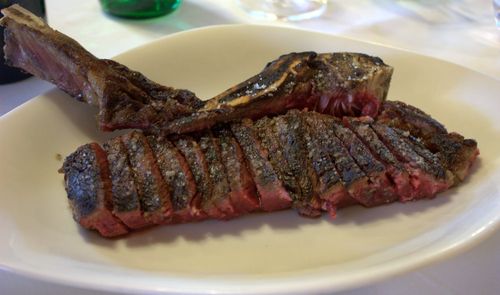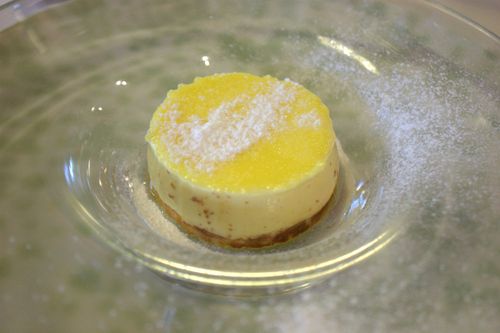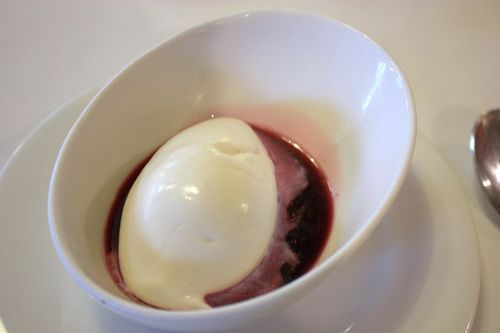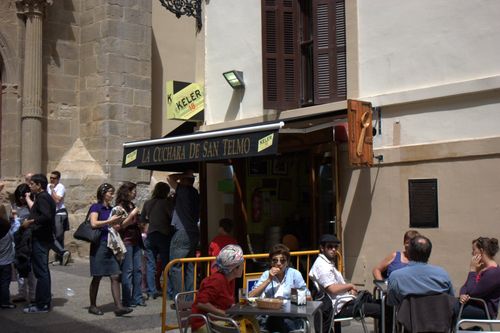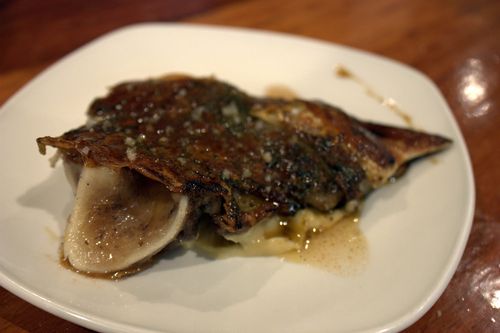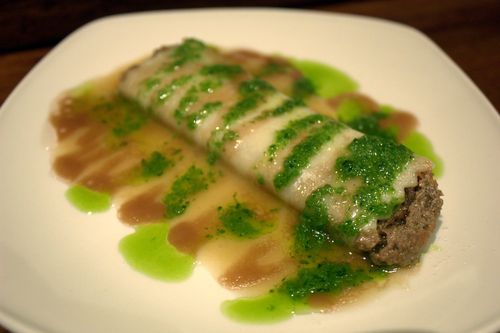 I’ve put off writing about the Michelin-starred portion of my now-ancient-seeming vacation (I already need another one!) because, honestly, if you follow restaurant blogs to any degree and even casually keep up on Spanish cuisine, you’ve probably seen countless versions of these photos before (I just chanced upon a stranger’s fresh Mugaritz batch this morning via vias on Twitter) and probably captured with more finesse. Maybe you’ve seen the potatoes that look like rocks or the haystack out front near the parking lot or maybe shots of a blogger in the pristine kitchen at Mugaritz (I didn’t ask—that’s just something nice they do). I was here, I ate this, I did this! Me too.
I’ve put off writing about the Michelin-starred portion of my now-ancient-seeming vacation (I already need another one!) because, honestly, if you follow restaurant blogs to any degree and even casually keep up on Spanish cuisine, you’ve probably seen countless versions of these photos before (I just chanced upon a stranger’s fresh Mugaritz batch this morning via vias on Twitter) and probably captured with more finesse. Maybe you’ve seen the potatoes that look like rocks or the haystack out front near the parking lot or maybe shots of a blogger in the pristine kitchen at Mugaritz (I didn’t ask—that’s just something nice they do). I was here, I ate this, I did this! Me too.
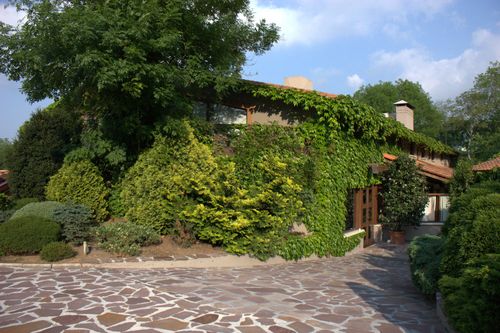
Who knows the motivations that drive the mortals paying out of their own pockets to travel to far-flung destinations, snap photos and post their uninfluential impressions online. Are they showing off, bragging? Sharing knowledge, being servicey? As the I Ate At El Bulli Pieces build to a crescendo (men named Adam are now helicoptering in? By the way, have you ever seen an IAAEBP not written by a man? ) I can’t fault a single non-Heather Graham (is Spain considering her a VIP like Hasselhoff being big in Germany?) for wanting to document and capture a memorable dining experience, despite the lack of vintage Dom Pérignon (at least none of the last call at El Bulli missives referred to it as champers, ugh) and five dozen courses. Mugaritz may not be El Bulli–and it doesn't need to be–but common folk should also be able to indulge in blathering on about their trips to Spain. Me, I like to dork out on food.
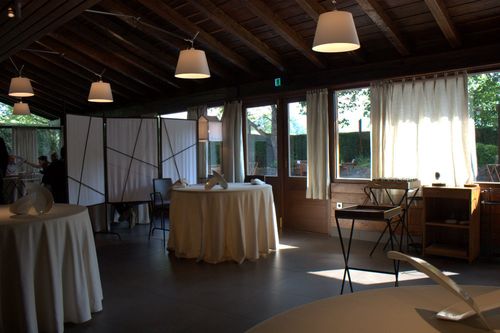
And not all food bloggers and Chowhounders are starry-eyed. Mugaritz is the most polarizing of the San Sebastián upper tier. That many say the service and atmosphere trumps the food, had me a little nervous. Yes, the cooking is far more conceptual than Extebarri and even more so than at Arzak, where experimental techniques are also employed (a little more playfully), but anyone with the means to do so should certainly experience Andoni Luis Aduriz’s food first-hand. At least once. Once might be enough for most. I would go back for a different season, if I lived closer by.

I went in a little blind, not scrutinizing Flickr beforehand or knowing much about the philosophy. I’m paraphrasing a bit but when given the kitchen tour a third of the way through the meal by one of the chefs, Oswaldo, he explained that they were “focusing on texture,” a worthy sense to explore and one less prized in the West unless we’re talking about popcorn and potato chip crunch—Americans love crunch. In parts of Asia, people enjoy the crackle of cartilage and fried bones, slipperiness of noodles and the mucilaginous quality of fermented soy.
At Mugaritz texture wasn’t being completely favored over taste, but prioritized to some degree. In fact, I was a little surprised to hear that they don’t use local produce, but cross the French border and shop at markets in Saint-Jean-de-Luz where the vegetables are smaller, better textured and the flavor concentrated. Despite a penchant for morphing ingredients, Mugaritz is very about nature. Once I realized this approach, my expectations shifted for the remainder of the meal and gave me a different perspective on what I had already eaten.
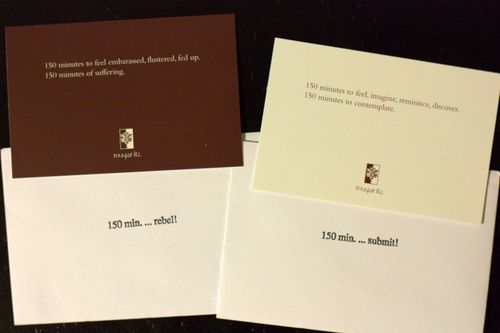
You’re given the option to submit or rebel. I wonder how much the menus vary because everyone seems to rebel. “150 minutes to feel embarrassed, flustered, fed up. 150 minutes of suffering,” you’re warned. When all of the amuses started arriving at once, willy-nilly with hard to catch explanations, some in English, some in Spanish (I took the suggestion of not seeing the menu ahead of time so everything would be a surprise) we joked, “It’s working–they are trying to fluster us!” I’m high-strung, so it doesn’t take much. But really, a tableful of treats to start has been the modus operandi at most modern Spanish restaurants I’ve dined at, not the one-by-one procession I've encountered in the US. This is when you can sit back and sip your aperitif; cava, non-vintage, if you’re me.

Piedras comestibles. The edible rocks with a kaolin (an edible clay, which I ate twice in this week, oddly–or maybe not for San Sebastián. I only knew what it was because a million years ago when I visited my sister after she first moved to the UK, I noticed an over-the-counter anti-diarrheal called kaolin and morphine. Did I just whet your appetite?) shell. These are served with an aioli for dipping and they’re sitting in a pepper mixture, probably the only pepper I encountered the whole spice-phobic week. Weirdly, these did not taste super-potato-like but kind of bland. Maybe it’s those French low-flavor vegetables at work.
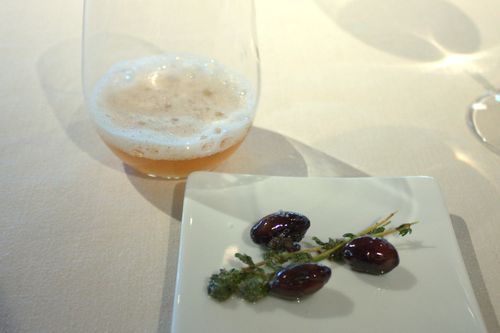
Cerveza de legumbres tostadas, tapa de olivas y alubias con tomillo. The warm “beer” made from toasted chickpeas and olives crafted from beans (for those who’ll never taste Adrià’s famous spherefied green olives) set the tone. The temperature and earthy, mealiness messed with the expected cold and yeasty, briny tastes.

Cristal de almidón y azúcar manchado con praliné y corales del buey de mar. I immediately started losing track of what was what—was this real sea urchin or “sea urchin?”—and stopped over-analyzing. Crackly and sweet like uni candy, I tried to enjoy the arrangements of the food as they were, not a puzzle.
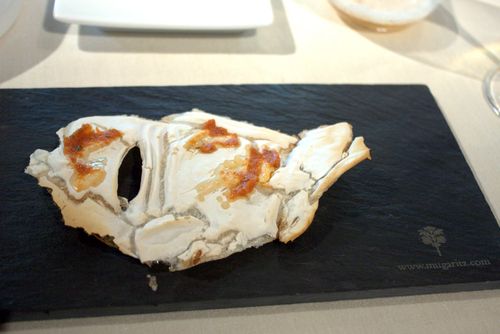
Focaccia de almidón de pueraria a la parilla. Brittle, crackle-bread skeleton, grilled and made of a powdered herb called pueraria. I don’t know what the tomato-y swipes were. Maybe a little challenging in its plainness.
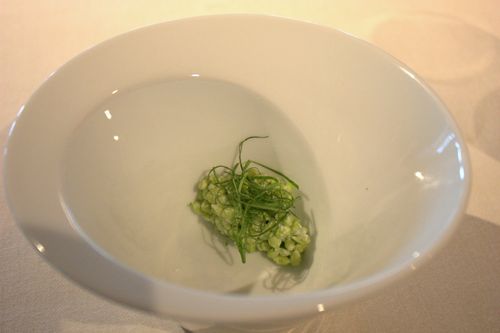
El verdor de guisantes lágrima animado con acederas rojas y mascarpone. Rice krispie peas without much distraction from the listed mascarpone.
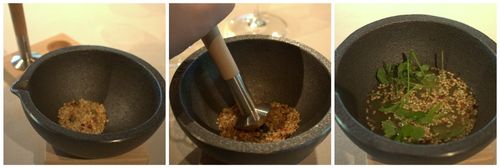
Sopa de mortero con especias, semillas, caldo de pescados y hierbas frescas. This broth epitomized Mugaritz for me. It was certainly some crunchy soup. Interactive dishes are tricky—how long should I pound this stuff before we move on to the next step? Sesames in your teeth, blasts of pink peppercorn, slightly bitter herbs so prominent, I barely even noticed the fish broth after it was poured. Flavor and texture.
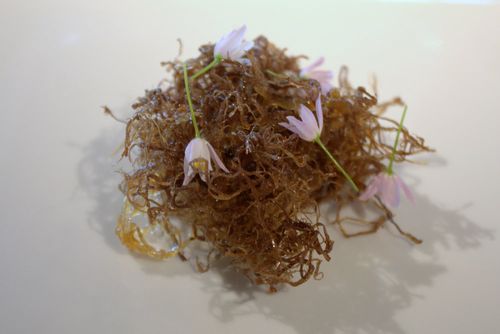
Shhh…muerdete la lengua. Ok, I do like puzzles even though I said above that I was trying to take everything at face value too. But in this case, we were told to guess the secret ingredient. Something beefy? Indeed, cow tongue had apparently been, cooked then pulled apart strand by strand (I would never have the patience to stage at a restaurant) and dried into floss. I’m crazy about meat floss, though I like mine fried, Thai-style full of chiles and shredded lime leaves. This was more purist, a little Brillo-y and it even had the dreaded flowers, while the predominant flavor was roasted garlic hidden inside the bramble. But when thinking back to Mugaritz over the course of a week, this is the dish that always came to mind first. Pretty, kind of grotesque, fanciful. I wouldn’t want to eat an entire meal of compositions like this, but I appreciated the diversion.
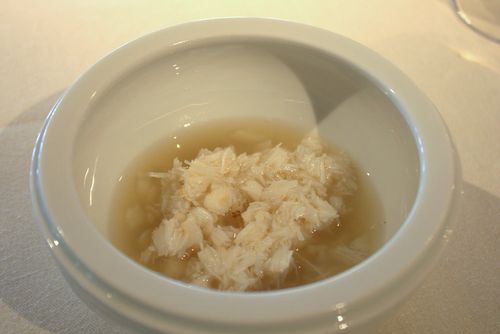
Potaje meloso de pan cubierto de carne de buey de mar y geránio rosa. I was not crazy about this one. Yes, yes, I’ve admitted my baby-ish aversion to flower petals in my food, but it’s purely a visual mental block. This soup, though, was completely perfumed with geranium, much worse than actually seeing petals. The shredded crab mixed with hunks of soggy torn bread created a white, floral sludge that was hard to finish. I can’t fawn over everything, right?

Potaje de avellanas con nácar. Similar to boiled peanuts, but hazelnuts with crispy pearlescent candy. I would not call this a potage.

Llomo de merluza servido en un jugo lechoso de brotes de coles estofadas. From here the dishes started veering more into what I’d call food food, rich, little, elegant bowlfuls. I’m not sure what cabbage shoots are, but they were as mild as the hake
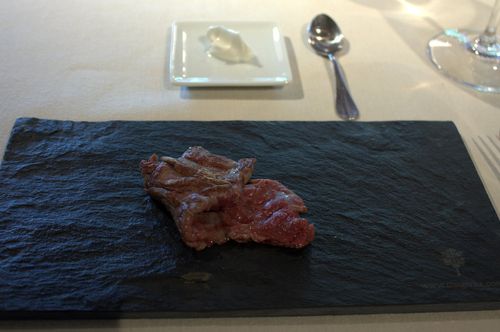
Láminas de entrécula, emulsión de carne asada y cristales de sal. A petite cut of beef from around the kidneys, the opposite of the region’s beloved txuleta, was served with an emulsified grilled meat butter that ranks right up there with Etxebarri’s smoked goat’s milk butter.

Ossobuco royal trabado con aceite de bogavante tostado. That would be ossobuco in quotes. I originally thought this was bone marrow, but it might be tendons. Whatever the silky nuggets may be, they’ve been cooked down to a hyper-concentrated, gelatinous state and flavored with lobster oil. This is where bread comes in handy.

Rabito de cerdo ibérico, hojas crocantes y aceite de semillas tostadas. The pig’s tail had been distilled to the point of two textures: opposites: gooey and crisp. Each bite pure pork. I have seen other photos of this dish with crackers on top. Maybe it’s better in its purest state? Another surprising thing we were told when in the kitchen earlier on was that we should feel free to voice any dislikes ahead of time (I would never say flowers, though I might think it) to let them know if we wanted more of something or another course. That seemed kind of outrageous to me like when my stepsister once asked for more mushrooms on her schnitzel at The Rheinlander (she got them). I wouldn’t feel right about it, but this would be the dish for sure. I could just be an gelatinous-umami maniac because the preceding dish had the same appeal. Of course, at this point you’re not really hungry for double-portions of anything.
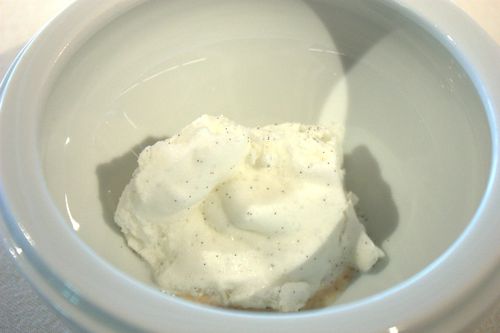
Brioche helado de vainilla con agua de cebada. Definitely more of a fluffy snowball than a brioche. I did not really notice the barley.
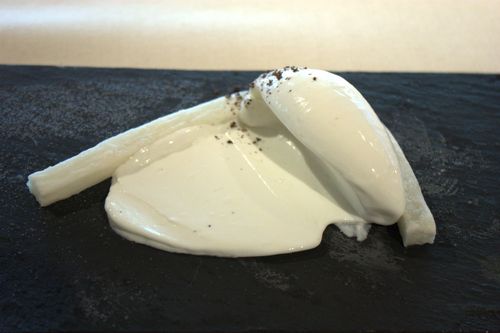
Crema fria de limon con nabo encurtido en azucar no dulce. White was the theme for desserts. This was lemony and served with what I thought was jicama but I’m now seeing was daikon. They both have that similar neutral crunch that could work in a dessert.
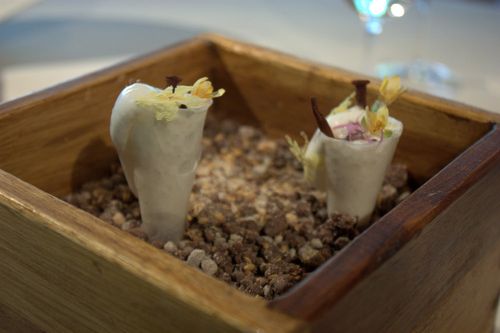
Cucurucho de flores y clavos. Flowers, ice cream and chocolate nails stuck into a box of chocolate dirt. It was interesting that they contrast the delicate with the utilitarian at the meal’s end. Arzak also has a send-off array of bonbons that includes candy nuts and bolts.
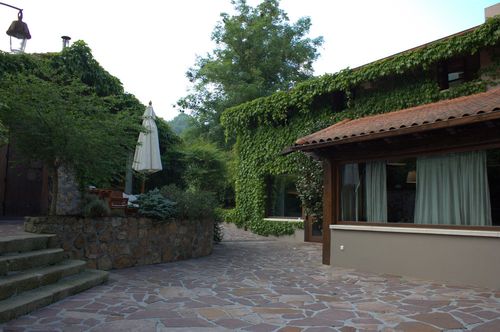
Afterward, lunchers retired to the still-sunny patio for coffee or a glass of cava—and a cigarette, the tell-tale sign that you may be surrounded by food-travelers, but not Americans.
Full set of Mugaritz photos.
Mugaritz * Otzazulueta Baserria. Aldura Aldea, 20, San Sebastián, Spain












 Follow
Follow
















 I briefly chatted with Elena Arzak as she said goodbyes to groups of lunchers slowly trickling out the door in time for what would be American dinner. When
I briefly chatted with Elena Arzak as she said goodbyes to groups of lunchers slowly trickling out the door in time for what would be American dinner. When 


















 El Corte Inglés is the Macy’s of Spain, and no great shakes, I know. But beyond the obvious culinary attractions of San Sebastián, I needed more bait to get James to take a vacation (if it were up to me, I'd stay out of NYC half the year). Having a mall and a subway (TV and internet access goes without saying) are the two unspoken requirements for cities we may visit.
El Corte Inglés is the Macy’s of Spain, and no great shakes, I know. But beyond the obvious culinary attractions of San Sebastián, I needed more bait to get James to take a vacation (if it were up to me, I'd stay out of NYC half the year). Having a mall and a subway (TV and internet access goes without saying) are the two unspoken requirements for cities we may visit.





